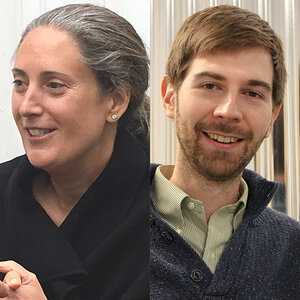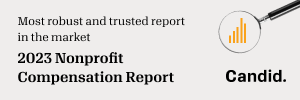Laura Callanan, Founding Partner, Upstart Co-Lab, and George Cook, CEO and Co-founder, Honeycomb Credit: Impact investing in communities
November 7, 2022
Last April, Upstart Co-Lab, a nonprofit that promotes impact investing in the creative economy, and Honeycomb Credit, a crowdfunding platform for small businesses seeking loan capital, launched a Loan Participation Fund initiative designed to enable institutional investors to provide loans to small businesses in creative industries. Launched with $600,000 in investments from the Jessie Ball duPont Fund (JAX Microfinance Fund, $250,000), the A.L. Mailman Foundation ($100,000), and Souls Grown Deep Foundation and Community Partnership ($250,000), the fund has now grown to $2.45 million in investments from five institutional partners.
The way the fund works is that when entrepreneurs on the Honeycomb Credit platform who meet a participating foundation’s criteria reach their minimum fundraising goals, they receive matching loan capital of $10,000. The businesses pay back the loans over four to five years at interest rates ranging from 8 percent to 14 percent, based on the risk characteristics of each business.
PND spoke with Callanan, founding partner of Upstart Co-Lab, and Cook, CEO and co-founder of Honeycomb Credit, about why and how the Loan Participation Fund was created, its impact to date on underinvested communities and entrepreneurs, and implications for the field of impact investing in the creative economy.
Philanthropy News Digest: What was the impetus behind the creation of the Loan Participation Fund—to address the historic lack of access to loan capital among women and people of color (POC) entrepreneurs, an increased need for small business loans as a result of the pandemic, or other issues?
Laura Callanan: As you know, Upstart Co-lab is focused on connecting impact investing to the creative economy. For the last three years we’ve been advising 10 families and foundations who have helped us pioneer this new focus within the impact investing space on art, design, culture, heritage, and creativity. The foundations that we’re working with are place-based, so they were especially looking for opportunities that they could bring to their city, their state, the community where they focus their philanthropic work. So we’ve been on the lookout for impact investing opportunities that target the creative economy and can be replicated in multiple places around the United States.
We were introduced to the folks at Honeycomb Credit by Margot Kane, who leads the impact investing team at Spring Point Partners. Margot observed that there were a lot of creative economy businesses on the Honeycomb platform. We found that 80 to 90 percent of the opportunities, in fact, were in creative industries. For Upstart Co-Lab, the creative economy includes restaurants, coffee shops, food trucks —businesses where food connects to culture, heritage, and community—as well as toy makers, furniture designers, jewelry makers. As we started to talk to George and his colleagues, we realized that they had been thinking about ways to start to work with foundations—in a creative way, different from other crowdfunding platforms.
There’s a third partner: FJC – A Foundation of Philanthropic Funds, led by Sam Marks. They’re a very important partner to this project, facilitating the mechanics. Foundations are happy to assign a $250,000 impact investment to this Loan Participation Fund, but they don’t want to make 25 $10,000 capital calls. So FJC plays that role managing the financial transactions.
George Cook: As a loan crowdfunding platform supporting small businesses to catalyze local community capital to fund their expansion projects, we have, since our inception, thought about the impact we’re having in the communities we serve. A lot of people inherently connect small businesses with impact—local job creation, a higher tax base, and more vibrant and fun communities. So we started to capture data around how different demographic groups were performing on our platform and found that businesses were pretty consistently hitting their target funding goals 80 percent or more of the time. But when we got a little bit more granular with the data, we started to see that businesses that are based in low-to-moderate income communities and businesses with a woman owner or a minority owner were less likely to hit their goals. And it intrinsically made sense, right? In communities that have been chronically underinvested, communities where there is definitionally less wealth, it’s harder to catalyze wealth from that community into businesses.
In communities that have been chronically underinvested, communities where there is definitionally less wealth, it’s harder to catalyze wealth from that community into businesses.
And this was weighing on us. We want our platform to be really equitable. We want to make sure that we’re supporting businesses that are often overlooked by traditional lenders and fully capitalizing them and setting them up for success. So we started to think about creative ways to bring other sources of capital on to our site. And right around the time we were starting to think through the approach to bring foundations and impact investors on, we were introduced to Laura. She had such great insights about how the foundation community works and how they’re thinking about the world, and she was able to help us put all of the pieces together.
PND: So it wasn’t because of the pandemic that you launched this project, and it wasn’t because of the pandemic that it took two years?
LC: That’s right, though I think that COVID helped everybody to appreciate their local coffee shop, restaurant, book store. I think it allowed people to value more deeply their communities and recognize how community-based businesses are an important part of what makes it great to live where they do. I’d be curious, George, if you saw more people coming to the Honeycomb platform when they were at home—if you regard COVID as a driver of crowdfunding because people were looking for ways to have an impact in their communities during lockdown?
GC: I think the pandemic certainly helped demonstrate the urgency of a lot of the work we were doing, but I think the zeitgeist and a lot of the macro trends were pointing in that direction beforehand. But yeah, I think a lot of people had that lightbulb moment of “Oh my goodness, I want to make sure my favorite restaurant’s there at the end of the pandemic!” And you could buy gift cards, and certainly people were getting creative about how to support small businesses. But this idea of investing in local businesses became a little bit more mainstream and more accepted, and I think that trend accelerated through the pandemic.
PND: Why is it important that the borrowers reach their minimum fundraising goals before they’re eligible to receive the $10,000 Loan Participation Fund capital?
GC: One of our core beliefs at Honeycomb is that to really, truly assess the risk of a small business, you need to look at both the quantitative health of a small business—the financials—and the qualitative. You need to understand if the business has a good product, if they treat their customers well, if they treat their employees well, if they are a good fit for the community that they’re serving. Those things help to identify if a business has true staying power in that community. And I think the industry as a whole has really lost sight of that second piece when evaluating small businesses, and everyone is trying to build a fancier algorithm to determine which businesses they’re going to lend to. And that, to us, is one of the underpinnings of how we think about credit risk and the performance of small businesses.
Are they loved by their community? If so, it’s a business that the community really wants to see grow and thrive. So from our perspective, it is sort of a risk metric to validate that the business has staying power—but with the additional benefit that it’s a very bottom-up grassroots initiative, where it’s not just a well-meaning foundation coming in and saying this community needs X project, but really the community is saying, “Hey, we really believe in this business and we want to see them take that next step,” and giving them the capital and the power to do that.
LC: We’ve been sourcing and screening a range of investment opportunities for foundations over the last three years, with this focus on the creative economy. This was a test case to see if foundations would go for the Loan Participation Fund. We were able to frame this to foundations in the context of philanthropy’s increasing emphasis on community-driven giving and community-driven decision making. The foundation’s money only goes to a company if the community helps the company reach its minimum fundraising goal. Only when the crowd endorses the company is the foundation’s money unlocked. We thought this was a very interesting and exciting way to help foundations meet their increased commitment to community engagement.
We thought this was a very interesting and exciting way to help foundations meet their increased commitment to community engagement.
PND: Of the three original foundation partners, the Souls Grown Deep and A.L. Mailman Family foundations are investing in Black-owned businesses in nine Southern states, while the Jessie Ball duPont Fund is focused on entrepreneurs in seven northeast Florida counties, with priority given to low-income, women, and POC borrowers. To date, how many small businesses has each foundation provided matching loan capital to? Can you provide breakdowns of creative industries and founder demographics?
GC: To date across all five partners we have deployed capital to 15 businesses in the creative economy, and that’s about $550,000. Of those businesses, 86 percent are Black-owned, 73 percent are women-owned, and 78 percent are in low-to-moderate income communities.
As for the three original Upstart Co-Lab members’ investments, a total of $292,500 has been deployed across the three Upstart Loan Participation Funds to 14 businesses; 92 percent are Black-owned, 64 percent are women-owned, and 92 percent are based in low-to-moderate income communities. They’re primarily in the food and beverage industry—a lot of restaurants, cafés, food trucks—but it runs the gamut; we’ve had beauty salons, a puzzle maker, and all sorts of different types of businesses.
PND: Since last spring, two more funders have joined the effort: impact investment firm Equity2 (Equity Squared, $250,000) and community development financial institution (CDFI) DreamSpring ($1.6 million). Are they focused on specific geographic areas or creative industries or founder demographics? Do you expect more CDFIs to come in with larger investments?
GC: Equity2 is an impact investor out of Kansas City, and they’ve joined the platform to invest in women-owned and Black-owned businesses across the State of Missouri; they’re focused on place-based investing in their backyard. DreamSpring is a New Mexico-based CDFI, and they’re lending across the country, and they, like many CDFIs, have had a lot of success in recent years as foundations and other impact investors and nonprofits and sources of capital have deployed capital to them. But as nonprofits, CDFIs often don’t have the resources to go and find the small businesses that need that capital. And what DreamSpring is really helping us prove is that Honeycomb can be the bridge between the capital and the businesses. We can go in and identify businesses that are looking for capital that are very diverse and are geographically distributed, and we can de-risk those businesses by validating their level of community support. And then we can tap into and work side by side with CDFIs to help them deploy capital to the types of businesses that they want to serve.
We’re having some really good conversations across impact investors, foundations, and CDFIs—in particular with CDFIs. A lot of them have access to a lot of capital that there’s increasing urgency for them to deploy, especially as [interest] rates are going up. So the fact that we’re able to source really high-quality deals and have that community vetting is pretty attractive.
LC: I think it’s very exciting to see CDFIs come on to the crowdfunding platform, and I’m glad that foundations were able to pilot this new approach and unlock additional capital beyond their own. Foundations have asked how crowdfunding through Honeycomb Credit compares and contrasts with CDFI lending—and whether it’s competition in a negative way or if Honeycomb is addressing a different segment of borrowers that CDFIs are not able to address. I think the fact that you’ve got a CDFI and an impact investing partner coming on to the platform using this model demonstrates that Honeycomb is providing a different type of capital to small business borrowers. In this example, philanthropy is the R&D capital for social change, piloting and demonstrating something new for other institutional impact investors.
[P]hilanthropy is the R&D capital for social change, piloting and demonstrating something new for other institutional impact investors.
PND: What impact has the Loan Participation Fund had on Honeycomb Credit’s borrower demographics so far?
GC: From 2018 to 2021, the early years of Honeycomb, 49 percent of the businesses we were serving were women-owned. In 2022, since we’ve launched this program, that number has jumped to 62 percent. In terms of Black-owned businesses, about 17 percent of the businesses we were working with were Black-owned, and that number has jumped to 32 percent—almost double. And more broadly, looking at minority-owned businesses overall, we were at 24 percent before; we’re now up to 47 percent. (The number of businesses in low-to-moderate income communities has stayed consistent around 40 percent.)
So across the board, this has been really exciting for us, because it really allows us to put impact first and make sure that we’re reaching really diverse business owners and continuing to diversify the types of businesses we’re able to work with. It’s all a very new idea, and so starting largely with food and beverage businesses has been kind of a gateway that allows us to think more broadly about who the addressable market is and what other types of creative economy businesses we can work with.
PND: Do you expect more members of the Upstart community of funders to participate in the Loan Participation Fund in the near future?
LC: We do. There is one foundation who I think will close with Honeycomb in the coming months, and there’s another foundation that will continue to consider working with Honeycomb going forward, both place-based foundations. So we’re excited about that. We’re also excited that the A.L. Mailman Family Foundation not only has invested through a Loan Participation Fund, but has also made an equity investment in Honeycomb Credit, the company.
GC: In terms of the equity investments we’ve received from foundations—$50,000 from the A.L. Mailman Family Foundation and $300,000 from the Richard King Mellon Foundation (RKMF)—that is such a vote of confidence, that not only is this a thing that they want to see exist in the community that they’re serving but also that they’re seeing the benefit. They’re seeing the community impact, and they want this to exist everywhere.
RKMF is really trying to put their foot forward as a leader and impact investing and they’re transitioning to that leadership role in the foundation community. So getting that endorsement from them to go out and have conversations with other foundations—that’s a real feather in our cap. That opens a lot of doors for us that, for a small scrappy startup, can be hard to open. So working both with A.L. Mailman and RKMF as investors and partners on this is helping us think much bigger about how this can be not just in isolated communities, but really starting to create something across the country.
(Photo credit for Laura Callanan headshot: Helga Sigvaldadottir)





